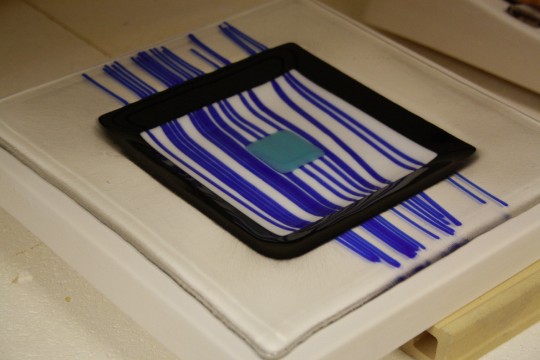The first point to remember is that you can not mix System 96 and Bullseye fusing glass in one project. This is due to the co-efficient of expansion difference (Bullseye is COE 90 and Spectrum / Uroborus System 96 is COE 96). This means that they expand and contract by different amounts when heated. When fusing, this means that glass could crack as it cools.
Both ranges of glass have an excellent range of colours, textures and accessories like frit, stringer and confetti. They both have lovely colours and streaky glass too. So what are the differences?
Firstly, sheet size (excluding clear base glass) Bullseye has a usual sheet size of 89cm x 51cm, Spectrum sheets are 122cm x 61cm (for their respective 3mm / 1/8" thickness, others may vary). There are however, certain glasses in the System 96 range, which are made to sizes simelar to Bullseye, these are usually produced by Uroboros Glass Co.
Bullseye is easily identified by it's rolled texture, which can be used to create bubbles in the glass. Spectrum 96 is smoother, and is far easier to cut as a result. With a good glass cutter and having practised your technique of course.
You will find that as COE increases, the amount of heat and time required in kiln forming is reduced. This is also particularly notable when flameworking with glasses like Moretti, Effetre, Murano which are 104 COE glass. This is 'soft' and ideal for working quickly when making lampwork glass beads. Using System 96 or Bullseye Glass in the kiln will require adjustments to the firing program. It is good to get to know your kiln controller and to be able to explore the possibilities created by changing the pre-set firing schedules. System 96 (having a higher COE number is slightly softer than Bullseye).
Preference and price are the main reasons why artists may choose one or other of the glasses, preference is personal, the colour palletes for either range may suit your project so don't rule either glass out. Just remember to keep your offcuts in separate boxes. Price varies, the System 96 Glass is significantly cheaper when looking at standard colours, however, there are exceptions on both sides.
Here at Creative Glass Guild, we aim to give you a broad choice of glass, with as much or as little help and support as you need. If you have any questions, feel free to email, call or pop in to see us.

